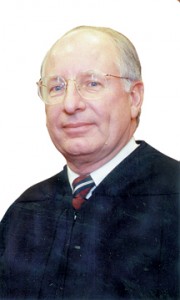In September 2008, Jason Kirkpatrick was sentenced after pleading guilty to 16 counts of breaking and entering and one count of engaging in a pattern of corrupt activity. The common pleas court judge in his case – Judge John Stuard – sentenced Kirkpatrick to five years of community control.
The term “community control” covers a wide variety of possible sanctions – such as financial, residential, and non-residential – that judges use in criminal sentencing. Those sanctions can include traditional probation supervision and numerous other restrictions administered by the local court.
Community control is used for felons when a prison term is not imposed and for people who commit misdemeanors when a jail term is not warranted. Residential community control sanctions include community-based correctional facilities, halfway houses and such. Non-residential options include community supervision, drug and alcohol treatment, house arrest, electronic monitoring, community service, and the like.
In Kirkpatrick’s case, in addition to community control, Judge Stuard required Kirkpatrick to enter and successfully complete a program called “Teen Challenge” (sometimes also called “Life Challenge”).
Judge Stuard warned Kirkpatrick that any violation of community control could result in the imposition of a nine-year prison term. So the stakes for young Mr. Kirkpatrick were quite high.
Unfortunately he didn’t follow the requirements of his community control. On April 16, 2009, after Kirkpatrick admitted to violating the terms of his release, Judge Stuard, following through on his warning, sentenced Kirkpatrick to a total prison term of nine years.
Kirkpatrick appealed the sentence. The court of appeals held that Kirkpatrick’s nine-year sentence for engaging in a pattern of corrupt activity exceeded the permissible two-to-eight year range for a second-degree felony. So the court sent the case back for resentencing.
Judge Stuard resentenced Kirkpatrick to a total prison term of nine years, and this time made it clear that eight of the years were attributed to the conviction for engaging in a pattern of corrupt activity. And the court of appeals affirmed the sentence the second time around.
On January 10, 2013, Kirkpatrick filed an action with the court of appeals seeking a writ compelling Judge Stuard to resentence him. Judge Stuard was no longer on the bench though, so Judge Ronald J. Rice was substituted as the new respondent in the appeal. Nevertheless, Kirkpatrick’s claims all arose out of alleged defects in the original 2008 sentencing order.
The court of appeals dismissed Kirkpatrick’s petition on September 16, 2013, in large part because Kirkpatrick’s allegations, even if true, were “legally insufficient to demonstrate that he has a ‘right’ to another sentencing hearing.”
After that ruling, Kirkpatrick filed an appeal with us – the Supreme Court of Ohio – and his case came here for a final review. Kirkpatrick argued that his first sentencing order is void, based on five defects.
His first two defects had to do with the “Teen Challenge.” In defect number one, he argued that the “Teen Challenge” is a 12-month program, but the maximum residential sanction under Ohio law is six months. For defect number two, he argued that the “Teen Challenge” residential sanction is void because the sentencing entry did not specify the length of the term.
His third defect dealt with his community-control. He maintained that the trial court did not advise him of several of the community-control sanctions on the record during the first sentencing hearing.
His fourth and fifth defects dealt with the “reserve” sentence. For defect number four, he argued that the first sentencing order failed to separately state the basis of the nine-year “reserve” sentence to be imposed upon a violation of community-control release. And on defect number five, he argued that because the nine-year “reserve” sentence exceeded the maximum sentence permissible for a second-degree felony, he did not receive valid notice of the reserve sentence.
Each of those contentions attacked the validity of the 2008 sentencing order. But that order has been superseded by not one but two subsequent orders. Therefore, Kirkpatrick’s contentions were moot.
In the end, Kirkpatrick offered only one argument to explain why defects in the 2008 sentencing entry should make the subsequent entries void as well. According to Kirkpatrick, because the “one-year alternative residential sanction was and is void…, there was no valid sanction to violate, and the Trial Court had no power to impose the reserve prison term.”
Actually, to the contrary, even if the 2008 entry were defective, the trial court still had jurisdiction to resentence him, given that Kirkpatrick had never challenged the validity of his guilty plea.
Going back to April 16, 2009 – Judge Stuard’s order from that date makes it clear that he sentenced Kirkpatrick to a term of nine years not as a punishment for violating community control, but because he considered nine years to be the appropriate sentence.
And Judge Stuard later corrected the error in that order when he sentenced Kirkpatrick to the nine-year sentence he is now serving. Kirkpatrick did not establish any defect in his current sentence, and therefore he showed no legal right to a new sentencing hearing.
A person seeking the type of writ that Kirkpatrick sought must establish three things. First, he must establish a clear legal right to the requested relief. Second, he must establish a clear legal duty on the part of the official or governmental unit to provide that relief. And third, he must establish the lack of an adequate remedy in the ordinary course of the law.
Kirkpatrick did not satisfy any of those three requirements. Therefore, based on the foregoing reasons – by a seven-to-zero vote – we affirmed the judgment of the court of appeals that Kirkpatrick’s allegations were legally insufficient to demonstrate that he has a “right” to another sentencing hearing.
Note: The case referred to is: State ex rel. Kirkpatrick v. Rice, 140 Ohio St.3d 398, 2011-Ohio-3958. Case No. 2013-1665. Decided September 17, 2014. Opinion Per Curiam.

